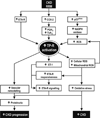Thromboxane prostanoid receptors enhance contractions, endothelin-1, and oxidative stress in microvessels from mice with chronic kidney disease
- PMID: 25733239
- PMCID: PMC4990073
- DOI: 10.1161/HYPERTENSIONAHA.115.05244
Thromboxane prostanoid receptors enhance contractions, endothelin-1, and oxidative stress in microvessels from mice with chronic kidney disease
Abstract
Cardiovascular disease is frequent in chronic kidney disease and has been related to angiotensin II, endothelin-1 (ET-1), thromboxane A2, and reactive oxygen species (ROS). Because activation of thromboxane prostanoid receptors (TP-Rs) can generate ROS, which can generate ET-1, we tested the hypothesis that chronic kidney disease induces cyclooxygenase-2 whose products activate TP-Rs to enhance ET-1 and ROS generation and contractions. Mesenteric resistance arterioles were isolated from C57/BL6 or TP-R+/+ and TP-R-/- mice 3 months after SHAM-operation (SHAM) or surgical reduced renal mass (RRM, n=6/group). Microvascular contractions were studied on a wire myograph. Cellular (ethidium: dihydroethidium) and mitochondrial (mitoSOX) ROS were measured by fluorescence microscopy. Mice with RRM had increased excretion of markers of oxidative stress, thromboxane, and microalbumin; increased plasma ET-1; and increased microvascular expression of p22(phox), cyclooxygenase-2, TP-Rs, preproendothelin and endothelin-A receptors, and increased arteriolar remodeling. They had increased contractions to U-46,619 (118 ± 3 versus 87 ± 6, P<0.05) and ET-1 (108 ± 5 versus 89 ± 4, P<0.05), which were dependent on cellular and mitochondrial ROS, cyclooxygenase-2, and TP-Rs. RRM doubled the ET-1-induced cellular and mitochondrial ROS generation (P<0.05). TP-R-/- mice with RRM lacked these abnormal structural and functional microvascular responses and lacked the increased systemic and the increased microvascular oxidative stress and circulating ET-1. In conclusion, RRM leads to microvascular remodeling and enhanced ET-1-induced cellular and mitochondrial ROS and contractions that are mediated by cyclooxygenase-2 products activating TP-Rs. Thus, TP-Rs can be upstream from enhanced ROS, ET-1, microvascular remodeling, and contractility and may thereby coordinate vascular dysfunction in chronic kidney disease.
Keywords: cyclooxygenase; mitochondria; oxidative stress; thromboxane; vascular remodeling.
© 2015 American Heart Association, Inc.
Figures





Similar articles
-
Endothelin-1-Induced Microvascular ROS and Contractility in Angiotensin-II-Infused Mice Depend on COX and TP Receptors.Antioxidants (Basel). 2019 Jun 22;8(6):193. doi: 10.3390/antiox8060193. Antioxidants (Basel). 2019. PMID: 31234522 Free PMC article.
-
Enhanced contractility of renal afferent arterioles from angiotensin-infused rabbits: roles of oxidative stress, thromboxane prostanoid receptors, and endothelium.Circ Res. 2004 Jun 11;94(11):1436-42. doi: 10.1161/01.RES.0000129578.76799.75. Epub 2004 Apr 29. Circ Res. 2004. PMID: 15117817
-
Enhanced Renal Afferent Arteriolar Reactive Oxygen Species and Contractility to Endothelin-1 Are Associated with Canonical Wnt Signaling in Diabetic Mice.Kidney Blood Press Res. 2018;43(3):860-871. doi: 10.1159/000490334. Epub 2018 May 30. Kidney Blood Press Res. 2018. PMID: 29870994 Free PMC article.
-
Oxidative stress and nitric oxide deficiency in the kidney: a critical link to hypertension?Am J Physiol Regul Integr Comp Physiol. 2005 Oct;289(4):R913-35. doi: 10.1152/ajpregu.00250.2005. Am J Physiol Regul Integr Comp Physiol. 2005. PMID: 16183628 Review.
-
Endothelial factors in the pathogenesis and treatment of chronic kidney disease Part I: General mechanisms: a joint consensus statement from the European Society of Hypertension Working Group on Endothelin and Endothelial Factors and The Japanese Society of Hypertension.J Hypertens. 2018 Mar;36(3):451-461. doi: 10.1097/HJH.0000000000001599. J Hypertens. 2018. PMID: 29120962 Review.
Cited by
-
Endothelin-1-Induced Microvascular ROS and Contractility in Angiotensin-II-Infused Mice Depend on COX and TP Receptors.Antioxidants (Basel). 2019 Jun 22;8(6):193. doi: 10.3390/antiox8060193. Antioxidants (Basel). 2019. PMID: 31234522 Free PMC article.
-
Signals From Inflamed Perivascular Adipose Tissue Contribute to Small-Vessel Dysfunction in Women With Human Immunodeficiency Virus.J Infect Dis. 2024 Jul 25;230(1):67-77. doi: 10.1093/infdis/jiae094. J Infect Dis. 2024. PMID: 39052698 Free PMC article.
-
Comprehensive analysis of the endothelin system in the kidneys of mice, rats, and humans.Biosci Rep. 2024 Jul 31;44(7):BSR20240768. doi: 10.1042/BSR20240768. Biosci Rep. 2024. PMID: 38904098 Free PMC article.
-
Changes in arterial pressure and markers of nitric oxide homeostasis and oxidative stress following surgical correction of hydronephrosis in children.Pediatr Nephrol. 2018 Apr;33(4):639-649. doi: 10.1007/s00467-017-3848-4. Epub 2017 Dec 1. Pediatr Nephrol. 2018. PMID: 29196979 Free PMC article.
-
Endothelial prostaglandin D2 opposes angiotensin II contractions in mouse isolated perfused intracerebral microarterioles.J Renin Angiotensin Aldosterone Syst. 2020 Oct-Dec;21(4):1470320320966177. doi: 10.1177/1470320320966177. J Renin Angiotensin Aldosterone Syst. 2020. PMID: 33094663 Free PMC article.
References
-
- Santoro A, Mandreoli M. Chronic renal disease and risk of cardiovascular morbidity-mortality. Kidney Blood Press Res. 2014;39:142–146. - PubMed
-
- Landray MJ, Emberson JR, Blackwell L, Dasgupta T, Zakeri R, Morgan MD, Ferro CJ, Vickery S, Ayrton P, Nair D, Dalton RN, Lamb EJ, Baigent C, Townend JN, Wheeler DC. Prediction of esrd and death among people with ckd: The chronic renal impairment in birmingham (crib) prospective cohort study. Am J Kidney Dis. 2010;56:1082–1094. - PMC - PubMed
-
- Cohen DL, Townsend RR. Hypertension and kidney disease: What do the data really show? Curr Hypertens Rep. 2012;14:462–467. - PubMed
Publication types
MeSH terms
Substances
Grants and funding
LinkOut - more resources
Full Text Sources
Medical
Research Materials

